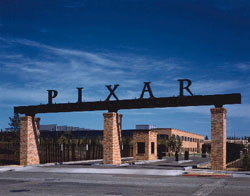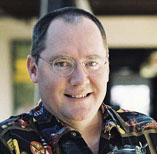|
Well for starters Pixar says it loud and clear – you can't rush art – and they don't. Of course it's difficult to rush an animation when every second of footage is comprised of 24 frames. And after the exhausting process and many stages of producing each frame it takes an average of 6 hours to render. Ok so it takes Time, massive amounts of it. Making an animated anything is an exhaustive process requiring deep pockets and heavy resources.
 In the film making game competition is high stakes, high budget, high pressure and there are no guarantees. So how come Pixar hits consistent home runs? Most studios I read about make their share of flops. Film making is an uncertain, risky business. Many films don't make it in terms of critical and financial success. There are no formulas for certainty and no guarantees. Yet every year hundreds of films are produced. Pixar, Disney's newly acquired partner has specialised in computer generated animation for the last twenty years. It was not until the advent of Toy Story in 1995 that most of us knew of their existence. As cited on the Pixar website Toy Story became the highest grossing film that year with worldwide box office receipts of over $360 million. In the film making game competition is high stakes, high budget, high pressure and there are no guarantees. So how come Pixar hits consistent home runs? Most studios I read about make their share of flops. Film making is an uncertain, risky business. Many films don't make it in terms of critical and financial success. There are no formulas for certainty and no guarantees. Yet every year hundreds of films are produced. Pixar, Disney's newly acquired partner has specialised in computer generated animation for the last twenty years. It was not until the advent of Toy Story in 1995 that most of us knew of their existence. As cited on the Pixar website Toy Story became the highest grossing film that year with worldwide box office receipts of over $360 million.
And three years later they repeated the same feat with A Bug's Life. Then in 1999 Toy Story II went off the charts with an unprecedented worldwide box office record of over $480 million becoming the first animated sequel to out gross its predecessor. In subsequent years Monsters Inc, Finding Nemo and The Incredibles have all broken their share of box office records – engrossing audiences all over the world in film, DVD, and video format.
Pixar films (including their shorts) target a wide audience - their website states their objective is to "...combine proprietary technology and world-class creative talent to develop computer-animated feature films with memorable characters and heart-warming stories that appeal to audiences of all ages." Clearly they are achieving this – from an outsider's perspective Pixar philosophy embraces true artistic imperatives with solid commercial fundamentals.
Leaving aside a discussion of business practices (although one clearly influences the other) focusing on some of Pixar's artistic practices might inspire us a little. My take on Pixar's creative culture comes principally from studying hours of behind the scenes footage. Pixar produce an abundance of material on each DVD edition of their films. My motivation over the past few years and with the help of my good friend Ed Hooks – has been to develop an understanding of Acting for Animators. I have been asked to run several classes at QUT (Queensland University of Technology) and QCA (Queensland College of the Arts) for the animation students. So naturally I looked to the best to help me understand how they think about acting and making animated films.
From these observations I have been astounded by Pixar's creative culture, artistic practice, and philosophy.
Konstantin Stanislavski knew the two most powerful ingredients to producing works of great art were Time and Ensemble. By design and by the very nature of producing animated film, Pixar have this. It takes three to four years to produce an animated feature film with hundreds of creatives involved at every level.
 So what are some of the ingredients that Pixar apply to their production process? The first thing I get when I tune in to 'education Pixar' is Story is King. John Lasseter says it, Brad Bird says it, they all say it. They have to get the story working. They pitch the story. Debate the story. Try it every which way and loose. Interrogate the story. Push it to its logical limits and then some. Who does this? The team – the ensemble. The nature of ensemble is collaboration and collective drive. They give it time. Passion and rigour and more time. Time and Ensemble. So what are some of the ingredients that Pixar apply to their production process? The first thing I get when I tune in to 'education Pixar' is Story is King. John Lasseter says it, Brad Bird says it, they all say it. They have to get the story working. They pitch the story. Debate the story. Try it every which way and loose. Interrogate the story. Push it to its logical limits and then some. Who does this? The team – the ensemble. The nature of ensemble is collaboration and collective drive. They give it time. Passion and rigour and more time. Time and Ensemble.
In every scene of any of their movies Pixar 'says the most with the least'. There is great economy, depth and detail. Getting a character's arms to bend in just the right place becomes one animator's passion. Making sure Mr Incredible has just the right amount of hair becomes another's. Getting an old lady's earlobes to wobble gives the degree of authenticity the animator needs. And he or she fights for it.
Although character animation is about caricature and ramping up characteristics, idiosyncrasies and situations, Pixar knows deep in their hearts that Relationships, Desires, Emotions and Thoughts have to be believable to the audience. They know that no matter how fantastical a caricature the audience must experience the character on an emotional level. So how do they do this? They get the animators to experience their characters. The animator says if I know and feel what my character is thinking and feeling then so will my audience. Acting for Pixar is right up there on the list of abilities they require for their animators.
As I watch the making of The Incredibles or of Monsters or any of the other great films the thing I get the most is Pixar's spirit of Creative Culture. In any enterprise be it learning or industry creating a culture that incorporates and holds the tension between such qualities as fun and rigour, decision and debate, product and process, technology and humanity, collaboration and individual contribution requires strong artistic sensitivity and vision. I get the sense that Pixar have set a benchmark to which many involved in creative enterprise might aspire.
There are no certainties in the movie business, you can't predict them. But so far something at Pixar is working. Given the resources, the strategies and the principles that Pixar possess, they are a living demonstration of getting the balance right: the balance between commercial imperatives and a respect for the unrushed journey; great films, great art, grown and formed in a crucible of integrity, passion and rigour.
|